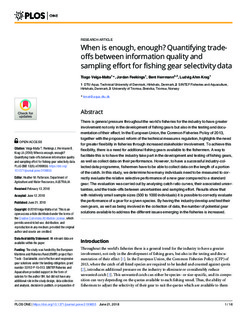| dc.contributor.author | Veiga-Malta, Tiago | |
| dc.contributor.author | Feekings, Jordan | |
| dc.contributor.author | Herrmann, Bent | |
| dc.contributor.author | Krag, Ludvig Ahm | |
| dc.date.accessioned | 2018-10-08T17:07:31Z | |
| dc.date.available | 2018-10-08T17:07:31Z | |
| dc.date.created | 2018-10-08T14:12:38Z | |
| dc.date.issued | 2018-06-21 | |
| dc.identifier.issn | 1932-6203 | |
| dc.identifier.uri | http://hdl.handle.net/11250/2566977 | |
| dc.description.abstract | There is general pressure throughout the world’s fisheries for the industry to have greater involvement not only in the development of fishing gears but also in the testing and documentation of their effect. In the European Union, the Common Fisheries Policy of 2013, together with the proposed reform of the technical measures regulation, highlights the need for greater flexibility in fisheries through increased stakeholder involvement. To achieve this flexibility, there is a need for additional fishing gears available to the fishermen. A way to facilitate this is to have the industry take part in the development and testing of fishing gears, as well as collect data on their performance. However, to have a successful industry-collected data programme, fishermen have to be able to collect data on the length of a portion of the catch. In this study, we determine how many individuals need to be measured to correctly evaluate the relative selective performance of a new gear compared to a standard gear. The evaluation was carried out by analysing catch ratio curves, their associated uncertainties, and the trade-offs between uncertainties and sampling effort. Results show that with relatively small sample sizes (500 to 1000 individuals) it is possible to correctly evaluate the performance of a gear for a given species. By having the industry develop and test their own gears, as well as being involved in the collection of data, the number of potential gear solutions available to address the different issues emerging in the fisheries is increased. | nb_NO |
| dc.description.sponsorship | Funding: The study was funded by the European Maritime and Fisheries Fund (EMFF) project Fast-Track - Sustainable, cost effective and responsive gear solutions under the landing obligation, grant number 33112-P-15-013. SINTEF Fisheries and Aquaculture provided support in the form of salaries for the author BH, but did not have any additional role in the study design, data collection and analysis, decision to publish, or preparation of the manuscript. The specific roles of this author are articulated in the ‘author contributions’ section. Competing interests: We have the following interests: Author Bent Herrmann is employed by SINTEF Fisheries and Aquaculture. There are no patents, products in development or marketed products to declare. This does not alter our adherence to all the PLOS ONE policies on sharing data and materials. | nb_NO |
| dc.language.iso | eng | nb_NO |
| dc.rights | Navngivelse 4.0 Internasjonal | * |
| dc.rights.uri | http://creativecommons.org/licenses/by/4.0/deed.no | * |
| dc.title | When is enough, enough? Quantifying trade-offs between information quality and sampling effort for fishing gear selectivity data | nb_NO |
| dc.title.alternative | When is enough, enough? Quantifying trade-offs between information quality and sampling effort for fishing gear selectivity data | nb_NO |
| dc.type | Journal article | nb_NO |
| dc.type | Peer reviewed | nb_NO |
| dc.description.version | publishedVersion | nb_NO |
| dc.rights.holder | Copyright: © 2018 Veiga-Malta et al. This is an open access article distributed under the terms of the Creative Commons Attribution License, which permits unrestricted use, distribution, and reproduction in any medium, provided the original author and source are credited. | nb_NO |
| dc.source.journal | PLoS ONE | nb_NO |
| dc.identifier.doi | 10.1371/journal.pone.0199655 | |
| dc.identifier.cristin | 1618743 | |
| cristin.unitcode | 7566,2,0,0 | |
| cristin.unitname | Sjømatteknologi | |
| cristin.ispublished | true | |
| cristin.fulltext | original | |
| cristin.qualitycode | 1 | |

